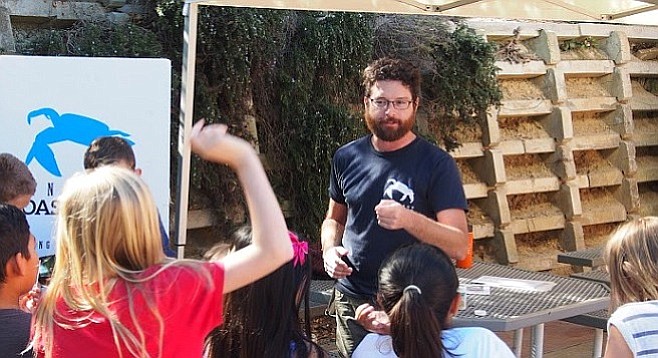 Facebook
Facebook
 X
X
 Instagram
Instagram
 TikTok
TikTok
 Youtube
Youtube

More than 100 elementary school students from Oceanside and Tijuana gathered Friday morning, November 7, at the Birch Aquarium at Scripps for the 12th annual World Water Monitoring Day.
"It's a global initiative to teach kids about water quality, and to help them connect what they do locally to what's happening in other parts of the world," explained San Diego Coastkeeper executive director Megan Baehrens. "Today is about teaching kids about water monitoring and why we do it."
"It's been a goal of ours to reach out to some of the schools in Tijuana, because the largest watershed in all of San Diego County is actually the Tijuana River, and 90 percent of that watershed is in Mexico. There's a real disconnect about our ability to control the quality of water there. These are kids on the other side of a political boundary, but it's not a boundary that can't be overcome by people working together."
Students rotated through seven interactive, hands-on stations set up inside and around the aquarium's perimeter, learning about the various challenges to maintaining clean waterways and a healthy water supply, such as fertilizer runoff or sewage spills.
"We're trying to help kids draw the line from effects [of pollution] back to the cause, so they can learn how to prevent pollution and its impacts," Baehrens continued.
One of the programs Coastkeeper oversees in addition to cleanup activities and environmental activism is a volunteer-led program that performs monthly water-quality monitoring at beaches and rivers.
Coastkeeper also partners with Think Blue as well as San Diego and Oceanside school districts to present Project Swell, a series of classroom science lessons centered around water issues aimed at fourth-to-sixth graders.


More than 100 elementary school students from Oceanside and Tijuana gathered Friday morning, November 7, at the Birch Aquarium at Scripps for the 12th annual World Water Monitoring Day.
"It's a global initiative to teach kids about water quality, and to help them connect what they do locally to what's happening in other parts of the world," explained San Diego Coastkeeper executive director Megan Baehrens. "Today is about teaching kids about water monitoring and why we do it."
"It's been a goal of ours to reach out to some of the schools in Tijuana, because the largest watershed in all of San Diego County is actually the Tijuana River, and 90 percent of that watershed is in Mexico. There's a real disconnect about our ability to control the quality of water there. These are kids on the other side of a political boundary, but it's not a boundary that can't be overcome by people working together."
Students rotated through seven interactive, hands-on stations set up inside and around the aquarium's perimeter, learning about the various challenges to maintaining clean waterways and a healthy water supply, such as fertilizer runoff or sewage spills.
"We're trying to help kids draw the line from effects [of pollution] back to the cause, so they can learn how to prevent pollution and its impacts," Baehrens continued.
One of the programs Coastkeeper oversees in addition to cleanup activities and environmental activism is a volunteer-led program that performs monthly water-quality monitoring at beaches and rivers.
Coastkeeper also partners with Think Blue as well as San Diego and Oceanside school districts to present Project Swell, a series of classroom science lessons centered around water issues aimed at fourth-to-sixth graders.
Comments